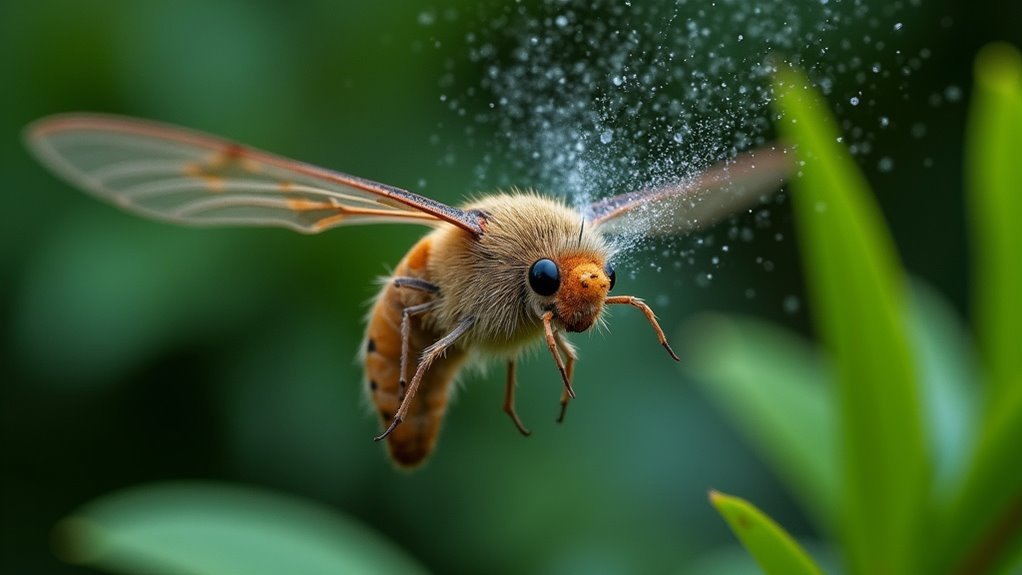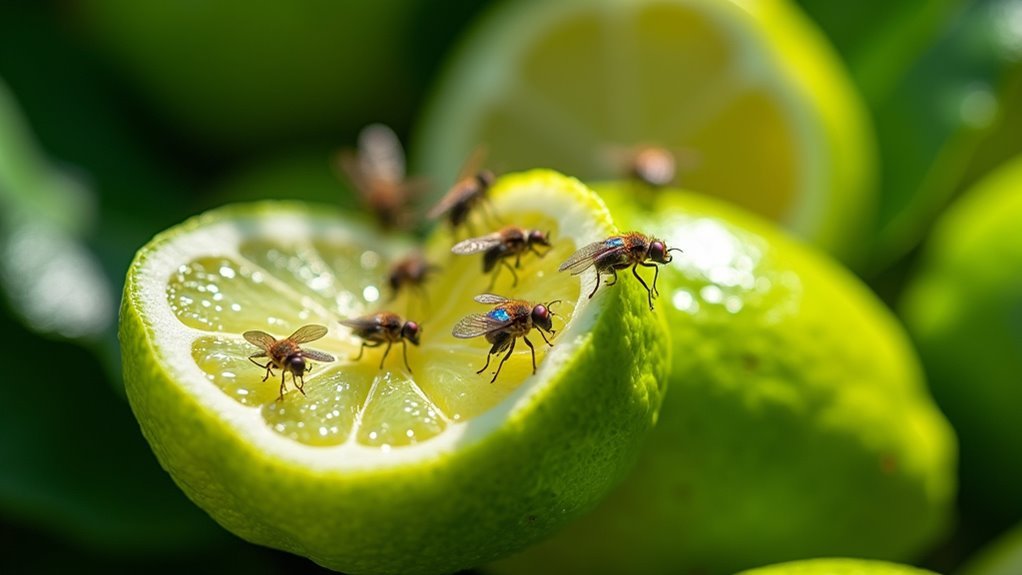Moths flee from acidic sprays because the low pH levels of 2.4-3.4 disrupt their navigation systems and trigger immediate escape responses. You’ll see them retreat when vinegar’s pungent smell blocks their ability to detect essential pheromones for mating and feeding. The acidic environment becomes hostile to their eggs and larvae, while altered chemical signals cause severe disorientation. Strategic application in cracks, crevices, and infested areas creates long-term barriers that prevent their return and establishment of breeding colonies.
How Acidic Vinegar Disrupts Moth Navigation Systems

When you spray acidic vinegar in areas where moths are active, you’re directly attacking their sophisticated navigation system that depends on detecting subtle chemical cues in the air.
The strong odors from acidic vinegar disrupt their sensitive olfactory receptors, making it nearly impossible for moths to navigate effectively. This disruption proves especially damaging because moths rely heavily on pheromones for mating and finding food sources.
Vinegar’s powerful scent overwhelms moth olfactory systems, effectively blocking their ability to detect essential pheromones needed for reproduction and survival.
The altered pH levels create an inhospitable environment that affects their eggs and larvae survival rates.
You’ll notice that vinegar’s pungent smell masks critical chemical signals, disorienting the moths completely. This interference prevents them from establishing breeding colonies in treated areas, as their fundamental navigation systems become compromised when exposed to acidic conditions.
The Science Behind Moths’ Immediate Flight Response to Acid
Beyond these navigation disruptions, moths exhibit an even more dramatic behavioral response when confronted with acidic substances.
You’ll notice their immediate flight response stems from remarkably sensitive antennae that detect chemical signals at incredibly low concentrations. When acidic sprays alter the environment’s pH levels, moths’ perception systems trigger instant escape behaviors. This survival mechanism evolved to protect them from potentially harmful substances threatening their well-being.
The acidic compounds create an inhospitable atmosphere that moths instinctively flee from. You can observe how these chemical signals cause severe disorientation, disrupting their sensory abilities and forcing rapid evacuation from the affected area.
This flight response isn’t random – it’s a sophisticated defense system developed over time to guarantee moths avoid dangerous environments and preserve their survival.
Vinegar’s Ph Level Creates Hostile Environments for Moths

Since vinegar maintains a pH level between 2.4 and 3.4, it creates an environment that’s fundamentally incompatible with moths’ biological needs.
You’ll find that these acidic properties directly target moth eggs and larvae, killing them upon contact while disrupting adult moths’ reproductive cycles. When you apply a vinegar solution to surfaces and fabrics, you’re altering the pH levels in ways that make these areas inhospitable for pest control purposes.
This acidic environment doesn’t just deter moths temporarily—it actively prevents them from establishing colonies in your storage areas.
You can safely use vinegar as an ongoing defense against moth infestation without worrying about toxic chemicals. The strong acidic smell alone signals danger to moths, making them avoid treated zones entirely.
Strategic Application Methods That Force Moths to Retreat
To maximize vinegar’s moth-repelling power, you’ll need to target specific areas where these pests congregate and breed. Focus your acidic sprays on cracks, crevices, and behind furniture where moth larvae develop. Altering pH levels in these hidden spaces creates hostile conditions that eliminate eggs on contact.
Consistent application disrupts pheromone signals, preventing moths from locating mates and laying eggs effectively. You’ll want to treat infested items directly while establishing a repellent barrier around high-traffic zones.
Regular vinegar applications interfere with moth mating patterns while creating protective barriers around vulnerable areas and directly treating contaminated items.
Combine treatments with thorough cleaning to remove food sources that attract moths initially. Monitor moth activity patterns and reapply sprays regularly to maintain effectiveness.
These preventative measures guarantee treated areas remain inhospitable, forcing retreating moths to seek alternative locations away from your protected spaces.
Long-Term Acidic Barriers That Prevent Moth Return

While immediate treatments eliminate existing moths, establishing permanent acidic barriers requires a systematic approach that transforms your storage areas into inhospitable zones.
You’ll need to create an acidic environment using white vinegar mixed with water in a 1:2 ratio. This solution targets moth eggs and larvae while preventing their return through consistent pH level alterations.
Regular cleaning storage areas with this acidic spray every few weeks maintains your barrier against moths. The vinegar’s pungent odor masks attracting pheromones, while the altered acidity disrupts their reproductive cycle.
You’ll maximize effectiveness by combining acidic treatments with vacuuming and steam cleaning methods.
This systematic approach creates a sustainable moth-free environment that continuously deters infestations through environmental modification rather than temporary elimination alone.
Frequently Asked Questions
What Is the Most Effective Moth Deterrent?
You’ll find combining multiple methods works best for moth control. Use pheromone traps, cedar products, lavender sachets, and regular vacuuming together. Don’t rely on just one deterrent—integrated approaches eliminate existing moths while preventing future infestations effectively.
Does Vinegar Spray Kill Moths?
Vinegar spray doesn’t directly kill adult moths, but it effectively kills their eggs and larvae upon contact. You’ll find it works best as a repellent, creating an acidic environment that discourages moths from entering treated areas.
What Scent Drives Moths Away?
You’ll find that lavender, cedar, peppermint, and eucalyptus scents effectively drive moths away. White vinegar’s pungent odor also repels them, while rosemary, thyme, and cloves create protective barriers that keep moths from entering your spaces.
What Is the Most Effective Way to Get Rid of Moths?
You’ll get best results combining white vinegar spray with natural repellents like cedar or lavender. Mix one part vinegar with two parts water, spray infested areas regularly, and add scented deterrents for thorough moth elimination.
In Summary
You’ve now learned how acidic sprays disrupt moths’ navigation, trigger their flight responses, and create unwelcoming environments. You can strategically apply vinegar solutions to force immediate retreats and establish long-term barriers that’ll keep moths away. Remember, it’s the low pH levels that make these treatments so effective. By implementing these five potent methods, you’ll successfully repel moths from your space while using safe, natural ingredients that won’t harm your environment.





Leave a Reply